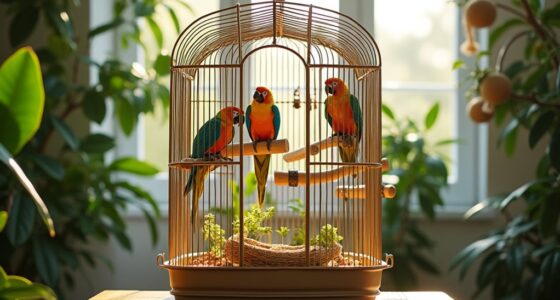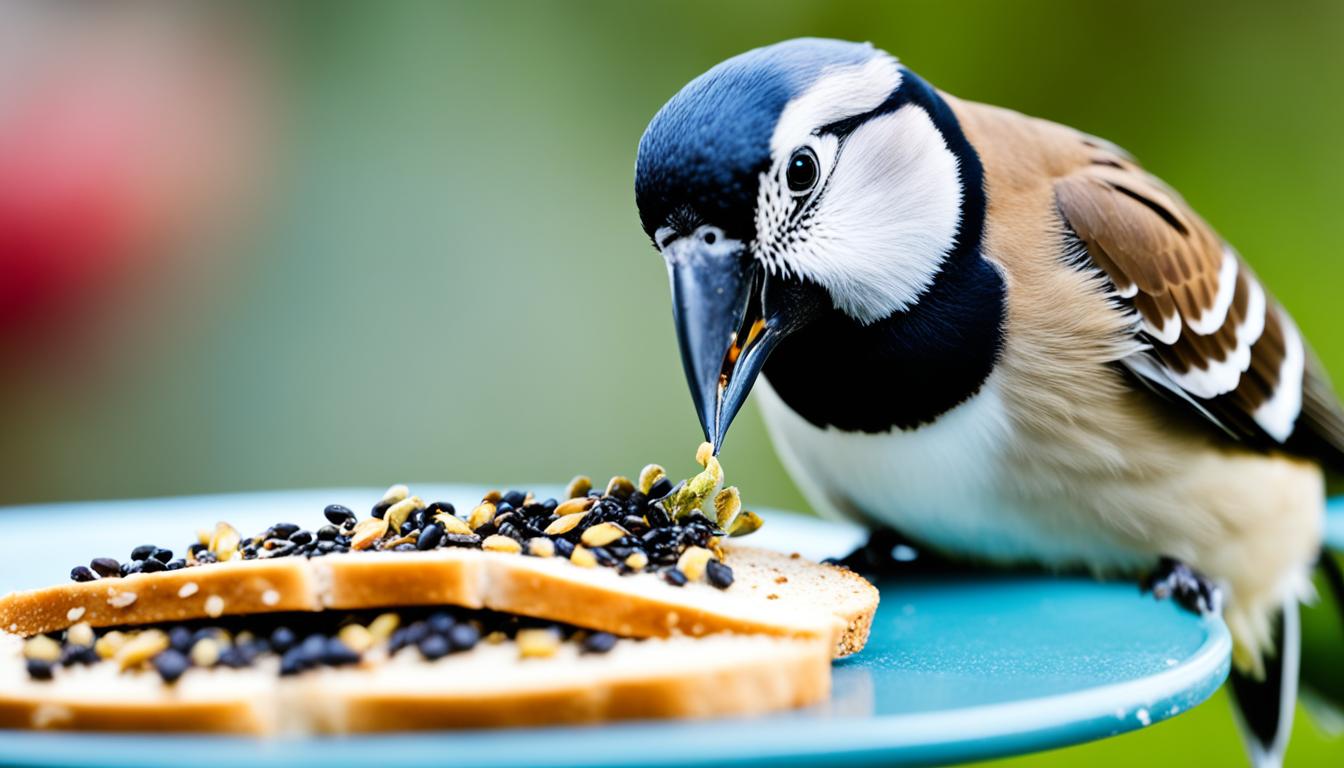Parrots pick up a surprising range of tricks and pranks by mimicking sounds from YouTube videos. They learn to imitate doorbells, phones, or funny noises, often surprising you with playful antics. Some even mimic phrases to prank or amuse you, turning everyday moments into mischievous surprises. Their vocal versatility keeps you on your toes, making pet ownership fun and unpredictable. Keep exploring, and you’ll discover even more clever tricks your feathered friend can imitate.
Key Takeaways
- Parrots imitate humorous sounds and phrases from YouTube videos to play pranks and surprise their owners.
- They mimic tricks and funny noises, often causing playful chaos in their environment.
- Video-inspired mimicry can lead parrots to perform unexpected behaviors, like mimicking doorbells or phone rings.
- Parrots learn mischievous behaviors by copying amusing actions seen online, fueling their playful antics.
- Owners can manage pranks by controlling the videos parrots watch and providing stimulating toys for mental engagement.

Parrots are clever birds known for their ability to mimic sounds and speech, making them perfect pranksters. When you observe a parrot in its cage environment, you quickly realize that their communication goes far beyond simple whistles or calls. They learn to use a variety of sounds, words, and even phrases, often mimicking noises they hear frequently. This ability to imitate is what fuels their mischievous behaviors, especially when they pick up prankster tendencies from videos online. You might notice your bird making surprising sounds or repeating funny phrases at just the right moments, catching you off guard and making you wonder if they’re trying to tell a joke.
Parrots mimic sounds and phrases, turning playful mischief into delightful surprises in their environment.
Understanding bird communication is essential when it comes to training or simply enjoying your pet’s antics. Parrots are highly perceptive and thrive on interaction. They pick up cues from their environment and the sounds they hear around them, including the noises from your TV, radio, or YouTube videos. When you watch videos of other parrots performing tricks or funny sounds, your bird often tries to mimic those same behaviors, adding a layer of playful mischief to their cage environment. They learn that certain sounds get reactions—whether it’s your laugh, surprise, or even a correction—and they love to test boundaries with these learned behaviors. Additionally, providing mental stimulation through interactive toys can help channel their intelligence positively and reduce unwanted mischief.
In the cage environment, your parrot isn’t just passively sitting around. Instead, it becomes a hub of activity and exploration, especially when it’s learned something amusing from a video. They might start making sounds that seem to surprise or confuse you, like imitating a doorbell or a phone ringing. Sometimes, they’ll mimic a phrase they’ve heard repeatedly, only to surprise you by using it at an unexpected moment. This can be their way of playing pranks or just showing off their latest learned skill. Their vocal versatility makes it easy for them to keep you guessing, turning everyday moments into opportunities for mischief.
To encourage this playful side while maintaining a healthy environment, you should be selective about what your bird watches or listens to. Provide a stimulating cage environment with toys and interaction, but also ensure that your bird isn’t overwhelmed by too many loud or confusing sounds. Recognize that their communication skills allow them to connect with you in unique ways, and with patience, you can enjoy their clever antics while fostering a respectful, engaging relationship. Ultimately, your bird’s ability to mimic and communicate keeps your home lively, unpredictable, and full of surprises.
Frequently Asked Questions
How Do Parrots Learn Tricks From Youtube Videos?
When you watch video tutorials, you may wonder how parrots learn tricks. Birds are great at mimicry, so they imitate what they see and hear. By repeatedly observing these videos, your parrot picks up behaviors through reinforcement and practice. They’ll imitate gestures, sounds, or actions, often surprising you. The key is consistent training and positive reinforcement, helping your bird master tricks just like in those engaging YouTube videos.
Are All Parrots Capable of Mimicking Pranks?
It’s ironic, isn’t it? You might think all parrots can mimic pranks, but their intelligence varies, affecting prank diversity. While some birds excel at clever tricks, others may lack the same mimicry skills. Parrot intelligence plays a vital role in their ability to pull off pranks, making it clear that not every parrot is equally capable. So, don’t expect a generic performance—each bird’s unique talent shapes its prank potential.
What Safety Precautions Should I Take When Trying Pranks?
When trying pranks with your bird, safety is key. You should bird-proof your space by removing hazards like sharp objects or toxic plants. Always practice emergency preparedness by having quick access to the phone and knowing emergency contacts. Keep an eye on your bird at all times to prevent accidents, and avoid pranks that could stress or harm your pet. This way, you enjoy fun safely and keep your bird healthy.
How Long Does It Take for a Parrot to Learn a Prank?
On average, it takes about 4 to 8 weeks for a bird to learn a prank, depending on their intelligence. Your success relies heavily on consistent training and understanding bird mimicry. You might notice progress faster if you repeat commands daily. Patience and persistence are key. By maintaining regular practice, you’ll enhance your bird’s learning and enjoy amusing pranks in just a few weeks.
Can Parrots Get Bored of Repetitive Pranks?
You might notice your parrot getting bored of repetitive routines or pranks over time. Parrots are intelligent and crave mental stimulation, so boredom can set in if you don’t keep things fresh. To prevent this, switch up activities, introduce new tricks, or vary the environment. Engaging your bird regularly helps keep boredom at bay, ensuring they stay happy, alert, and entertained instead of losing interest in familiar routines.
Conclusion
So, savvy bird owners, stay vigilant and vigilant against the vibrant, viral videos that tempt your parrots to imitate mischievous moves. Recognize the risks of reckless reproductions, and remember: patience and proper training trump tempting tricks. By fostering a fun, focused environment, you’ll foster faithful friends instead of frenetic fancies. Keep your curious companions cautious, and your home harmonious, because a well-watched bird is a well-behaved bird.










